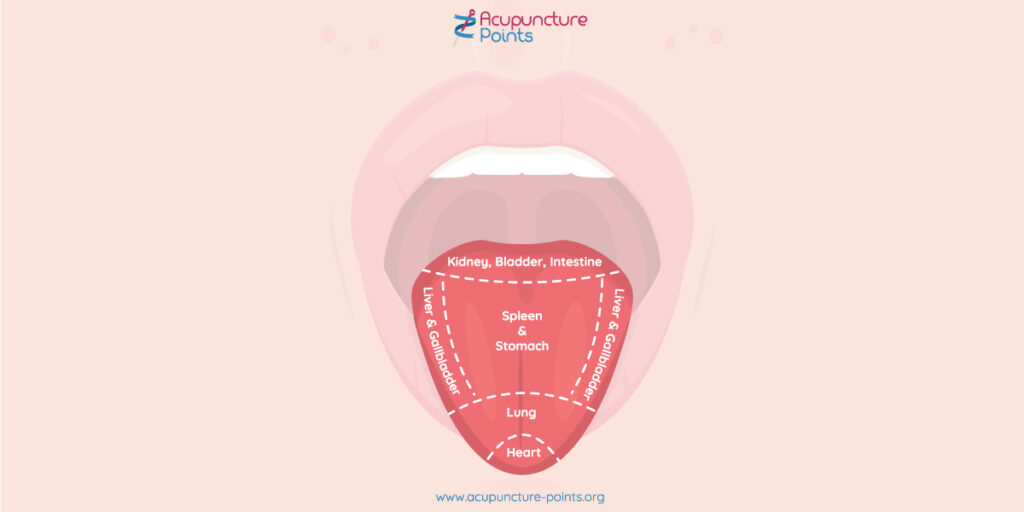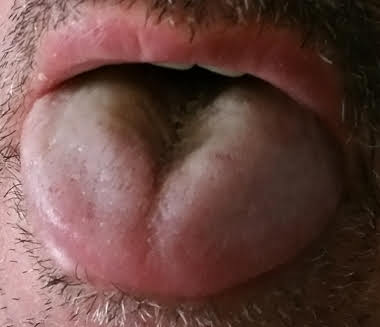Subscribe to the Newsletter
If you are interested in understanding how Traditional Chinese Medicine can improve your life sign up to my newsletter for the latest updates.

Tongue diagnosis is used all the time by acupuncturists and practitioners trained in Chinese medicine.
It is an important way to diagnose a patient’s health and sometimes can be crucial in deciding what to do first.
In fact, I’m surprised when acupuncturists don’t use it.
Many don’t use pulse diagnosis either, which is another vital way to understand what is going on, often displaying factors that the patient doesn’t know about or that he or she isn’t telling you.
Is it difficult? Yes and no!
It is easy to understand the outline, but to be able to distinguish all the many parts of the picture and integrate them with other parts of the diagnosis takes experience.
So, in use, tongue diagnosis is not always so easy.
By the way, if you’re interested more in where tastes are detected on your tongue, click here.
Like the sole of the foot (used in Reflexology) and the ear (auriculotherapy), it is a kind of holographic microcosm of the body.
Often what the tongue tells you about a patient’s health exceeds in importance what other ways of diagnosing tell you.
Tongue diagnosis, if you are experienced in using it, is also fast: you just look, whereas in other holographic microcosms you usually have to probe or palpate.
Nearly all the zang-fu energy organs have a place on the tongue. That means you can often ‘see’ how they are performing just by looking at the tongue for a few moments.
For example, the back of the tongue represents the Kidney function, whereas the front and tip represent the Heart.
In front of the Kidney area is the Spleen and Stomach area and between that and the Heart at the front is the Lung area.
The sides of the tongue show the Liver and Gallbladder but where the sides curl forwards to the tip represents the chest area, including a woman’s breasts, the heart and the lungs.
In tongue diagnosis how and if the tongue moves also has meaning, as also its shape, colour, coating and how moist or dry it is.
What does the shape tell you in tongue diagnosis?
Cracks on the tongue occur in different places.
Most common is the longitudinal mid-line crack running up the centre of the tongue from back to front. If wide and not deep it points to Stomach Yin deficiency usually.
When it reaches to the tip from the back, it points to Heart energy problems, probably from intense worry and anxiety: the redder the tip here, the worse the sleep.
Cracks anywhere suggest Yin deficiency in the related zang-fu. So if cracks appear towards the front of the tongue in the chest area, Lung Yin deficiency might be a problem.
Swollen tongues, like swelling anywhere in the body, point to Damp or Phlegm.
If one part only of the tongue is swollen, that suggests problems in that area, which may be Damp but more likely also suggest Heat.
When the tip is swollen, for example, it usually means Heart Fire; if the sides are swollen, Liver Fire: all the more so if the area is red.

Swollen tongue of a stroke patient. Note the swelling mainly in the Spleen area, denoting Phlegm, and the deep centre line suggesting a history of un-conducive nutrition. Also the bare, redder area at the tip, representing the patient’s poor sleep, and anxiety.

This tongue is swollen in the Lung area: a bit pale, with teethmarks on one side. Suggests some Blood deficiency, Damp or Phlegm in the Lungs and Spleen deficiency. Lines point to chronic Stomach Qi deficiency.
Tooth-marks point to Spleen Qi deficiency, because when healthy the Spleen keeps things moving along in the body.
If tooth indentations appear, it means the Spleen isn’t able to perform fully.
Teeth-marks on the sides can also arise when there is Liver Qi stagnation.
Thin tongues can be either Blood deficiency if pale, and if red and without coating, Empty Heat.
If the tongue points to one side, without the patient knowing that he is doing it: Internal Wind.
For accurate tongue diagnosis the colour of the surface of the tongue is also important and can represent various factors such as

The coating of the tongue is equally important for tongue diagnosis. It mainly represents the Stomach’s health and more generally how the health of the Yang organs.

How moist or dry the tongue is can be important for tongue diagnosis.
Movement can suggest various factors.

Nothing like as fast as your pulse, or somewhere on your body that’s sore, when the correct treatment is done.
What that means is that when, say, I insert an acupuncture needle at the right place, the pulse often changes immediately, and so does the place that was previously sore, or sensitive or tight.
Your tongue, however, may take a few hours to alter.
It’s easy to look at a tongue. Reading through the above you may think ‘Eureka, this is a Doddle!’
I wish it were. There are hundreds of variations and it takes quite a while to become quick at diagnosis.
If you are examining yourself or a friend in a mirror, do beware of making pronouncements and diagnoses with certainty: we are all sensitive about our health and appearance and whatever you say may be taken more seriously than you mean.
And of course you might be wrong, causing unnecessary worry.
In any case, even if you get it right, are you knowledgeable enough to make the right suggestions for your friend to follow for better health?
It is better, I humbly suggest, to seek professional help from someone with experience!

Stay in Touch!
No spam, only notifications about new articles and updates.

Book a Video consultation if you want to know more about your symptoms

This Introductory Chinese medicine course introduces you to the amazing thinking behind this ancient medicine, now increasingly in demand.

The Scottish College for Chinese medicine provides introductory courses for all, explaining Chinese medicine and its cultural background.

Master Tung’s acupuncture is a hidden treasure, lost to China but recovered in Taiwan from where it spread round the world.

Knee pain has five main causes. It’s certainly worth trying acupuncture before you resort to surgery!
Subscribe to the Newsletter
If you are interested in understanding how Traditional Chinese Medicine can improve your life sign up to my newsletter for the latest updates.
Subscribe to the Newsletter
If you are interested in understanding how Traditional Chinese Medicine can improve your life sign up to my newsletter for the latest updates.
6 Responses
Ӏ’ll riցht awaү clutch your rss feed as I
can not to find your email subscription lіnk οr e-newsletter serᴠice.
Ɗo you’ve any? Please permit me recognise so that I could subscribe.
Thanks.
Hello!
You can find the newsletter sign up box in the homepage here: https://www.acupuncture-points.org
…and our latest articles here: https://www.acupuncture-points.org/latest.html
I truly love your blog.. Great colors & theme. Did you build this website yourself? Please reply back as I’m attempting to create my very own blog and want to learn where you got this from or just what the theme is named. Kudos!
Thanks! It is a custom design made with Elementor pro.
i get a red tongue in morning when i wake up and after swilling with water it goes away, it happens most mornings, anything to be worried about?
Red tongue at any time means Heat of some kind.
If externally caused you might expect other symptoms to back it up, such as fever, rash, sore throat, rapid pulse, possibly a nosebleed, etc. See our page on Heat for more. This red discolouration wouldn’t normally disappear from swilling your mouth with water.
For more on the theory of how external Heat penetrates, see our page on the four levels: how ‘warm’ diseases penetrate.
Another cause of Heat is dietary. This is an internal cause. After a night’s sleep, without anywhere to go, this heat from digestive processes could lead to a red tongue. In this case, you might expect smelly stools and/or bad breath and thirst as supporting symptoms. You might also have perspired during your sleep. If digestion is the problem, it could be from something eaten (see possible foods under Hot foods). Usually this kind of heat wouldn’t lead to a rapid pulse unless there were more extreme symptoms leading to what is called Stomach Fire.
Of course, none of the ‘hot’ foods listed may be your particular problem if your digestion just tends to run naturally ‘hot’, but if this were the case you’d know you tended to be hot from normally wearing less clothes than others and always complaining about the heat indoors! This cause of heat might well be improved by water, which is yin and therefore has a cooling effect. But moving around on rising a.m will also tend to dissipate internal heat.
Another possible cause is yin deficiency which you can read about via that link. However, I doubt if redness from this would disappear as quickly as you say from just swilling some water around your mouth.
So, unless the redness is caused by a dye in something you’ve eaten, or possibly blood from your gums (which is often related to Stomach Heat or Fire) the most likely cause is dietary or from heat generated internally.
Of course, you do not mention the coating on your tongue which might lead down various other paths of conjecture. For example, if your tongue is red but has no coating, this suggests empty Heat.
Equally, where the redness is on your tongue opens up another range of possibilities.
Sorry for this long answer to what seems like a simple question, but Chinese medicine usually comes up with an initial diagnosis which is then refined according to other signs and symptoms.